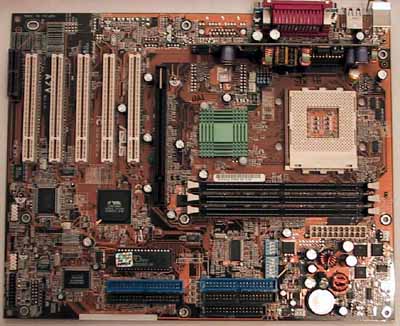Socket-A VIA KT133 Motherboard Roundup - November 2000
by Henry Kuo on November 30, 2000 5:15 AM EST- Posted in
- Motherboards
ASUS A7V
|
ASUS A7V |
|
|
CPU Interface
|
Socket-A
|
|
Chipset
|
VIA KT133
|
|
Form Factor
|
ATX
|
|
Bus Speeds
|
100
/ 103 / 105 / 110MHz
|
|
Voltages Supported
|
1.30 - 1.85V in 0.05V increments
|
|
Memory Slots
|
3 168-pin DIMM Slots
|
|
Expansion Slots
|
1 AGP Slot
5 PCI Slots (3 Full Length) 0 ISA Slots 1 AMR Slot |
|
On-board Audio
|
N/A
|
|
BIOS
|
Award Modular BIOS 6.00PG
|
The ASUS A7V is definitely a board with good performance and stability marks while providing a lot of options for users to tweak the board as well.
One of the most noticeable things about the board is the vertically mounted PCB pictured below, which has a lot of capacitors and voltage regulators on it. This helps to clear out the area around the CPU socket, allowing for larger heatsinks to be installed without much trouble.
Just like the ABIT KT7-RAID, during the first influx of KT133 motherboards, the ASUS A7V was one of few solutions that had multiplier adjustment settings. However, unlike ABIT, the settings are done through a set of dipswitches on the board and not in a jumperless fashion. ASUS does allow for voltage control as well.
ASUS also felt that the two traditional IDE channels were not enough, so they added in another IDE controller. The one they use is the Promise PDC20265 Ultra ATA 100 IDE controller, which supports two IDE channels (up to four Ultra ATA 100 devices). Together with the traditional IDE connectors, you can connect up to 8 IDE devices. However, ASUS came a bit shy by not having a RAID controller like what ABIT did. Therefore, for users who need RAID configuration, the A7V is simply of the question. The main goal for ASUS with the Promise chip was to bring ATA/100 support to the A7V since VIA’s 686B did not make it out until recently.
Furthermore, ASUS believed that the 2 USB root hubs (supporting up to 4 USB devices) provided by the VIA 686A South Bridge were not enough, so they added in yet another USB controller, which supports three extra USB connectors. ASUS even includes the necessary USB headers so that users can take full advantage of the extra USB controller. As USB devices increase in popularity, having support for 7 USB ports on-board (only 4 ports have headers unfortunately) can come in handy.
ASUS has
quite a few OEM contracts and therefore the inclusion of an AMR slot was reasonable,
though most AnandTech readers probably will not use it. ASUS also includes
an AGP Pro slot. However, we have yet to see a video card that truly needs
the AGP Pro slot for proper operation.












0 Comments
View All Comments